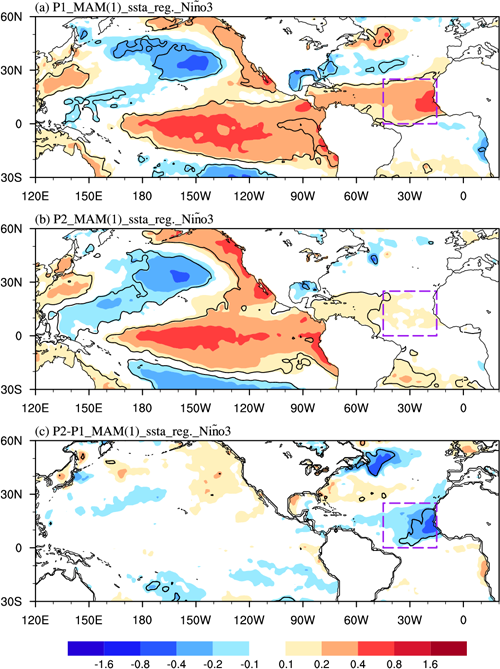The Influence of ENSO Doesn't Prevail to the Eastern Part of the North Tropical Atlantic after the Mid-1980s
As the most dominant mode in interannual timescale, El Nino-Southern Oscillation (ENSO) generates atmospheric teleconnections to remarkably modulate the sea surface temperature anomalies over the north tropical Atlantic (NTA), which further affects climate phenomenon over the surrounding and remote region.
Previous studies have indicated that the impact of ENSO on the SSTA over the entire NTA tends to be unstable. However, a study recently published in
Journal of Climate by researcher at the Institute of Atmospheric Physics, Chinese Academy of Sciences, China, identifies that the decadal variation in the ENSO-NTA connection actually concentrates over the eastern part of NTA (NETA), while the connection between ENSO and the sea surface temperature anomalies over the western part of NTA is stable. The results suggest that the influence of ENSO conveys to the entire NTA before the mid-1980s, but thereafter, the influence hardly arrives the eastern part of NTA and only limits over the western part.
"The decadal changes in the ENSO-NETA connection is due to the westward shift in the ENSO-related convection and teleconnections, resulting from the westward shift of Pacific Walker Circulation, induced by the intensified zonal SST-gradient over the equatorial Pacific after the mid-1980s", The author Dr. CHEN Wei said, "Our result implies a decadal variation in the ENSO-related NETA sea surface temperature anomalies, which may change the climate structures in the surrounding area."
Regression of spring SSTa onto the previous winter Nino 3 index. a (b) is for the period before (after) the mid-1980s; c is for the difference between the two periods. The purple boxes represent the eastern part of the NTA. (Image by CHEN Wei)
Citation:
Chen, W., 2022: A Decadal weakening in the connection between ENSO and the following spring SST over the northeast tropical Atlantic after the Mid-1980s. J. Climate, 35(9), 2867–2881, https://doi.org/10.1175/JCLI-D-21-0698.1.
Media contact: Ms. LIN Zheng, jennylin@mail.iap.ac.cn

